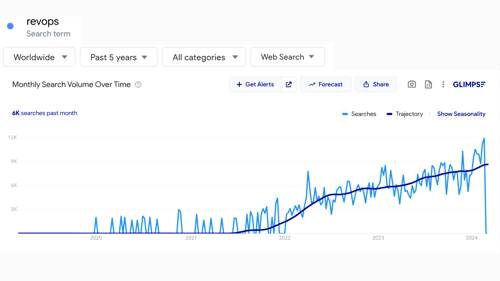60-Second Summary
Revenue Operations is one of the fastest-growing roles in business, uniting Sales, Marketing, and Customer Success into a single revenue engine. At its core, RevOps breaks down silos, aligns teams, and creates a single source of truth for data, enabling smarter decision-making and predictable growth. RevOps teams oversee pipeline analytics, forecasting, CRM optimization, financial reporting, and customer health metrics, all while tackling challenges like data silos, legacy systems, and siloed KPIs. The opportunities are vast: faster revenue growth, improved retention, operational efficiency, predictive analytics, and competitive differentiation. Effective RevOps requires rigorous benchmarking (conversion rates, customer lifetime value, acquisition costs, recurring revenue growth) and structured planning across quotas, territories, incentives, marketing, and product strategy. Critically, RevOps alignment goes beyond revenue teams - ensuring compensation, product roadmaps, and customer experiences all support long-term growth. The future of RevOps is a digitally transformed, customer-centric revenue machine that drives efficiency, scalability, and sustainable competitive advantage.
---
Revenue operations, or RevOps for short, is the hottest new role in business and the fastest growing role in the US.
Did you know there was a 52% increase in Google searches for RevOps in the last 12 months alone?
It’s kind of a big deal.

But what exactly does a RevOps team do? And how can RevOps help your company hit its revenue goals?
Let’s dive into the rock and roll of the business world – loud, a bit chaotic, but undeniably the beating heart of revenue generation.
What is RevOps?
You've got Marketing, Sales, and Customer Success all doing their thing in different corners of the business. RevOps is the force that swoops in to unite them all.
Aligning these teams, breaking down silos, and ensuring everyone's marching to the same beat is RevOps’ ultimate goal. It's not just about increasing revenue; it's about doing it with strategy, efficiency, flair and finesse.
What does RevOps do?
The RevOps team uses data to strategize the GTM function and systems to improve efficiency, increase revenue, and enhance the customer experience.
In other words, RevOps is a mashup of revenue-focused skills and specialties. It brings together all the critical pieces needed to keep revenue flowing smoothly. This includes sales operations, marketing operations, analytics, technology, and more.
RevOps is often compared to DevOps, which combines development and IT operations. Just like DevOps streamlines software releases, RevOps aims to create a well-oiled revenue machine.
In terms of their day-to-day, the role of a RevOps professional will vary hugely depending on the size of the team. If you’re lucky enough to have a Marketing Ops, CS Ops, Sales Ops or General Operations manager working alongside you, the projects you undertake as RevOps will vary in number and scale.
RevOps challenges
With so many moving parts and working across so many departments, RevOps face plenty of challenges. Here are some of the most common:
- Data silos: Important revenue data often gets trapped in departmental silos. RevOps needs to break down these walls and create a single source of truth.
- Data quality: RevOps is only as good as the underlying data. Cleaning up dirty data strains time and resources.
- Changing processes: RevOps requires changing ingrained habits and processes across sales, marketing, finance and more. This change management can face internal resistance.
- Proving value: As a new function, RevOps must prove its value in revenue growth and operational efficiency. And quantifying this can be difficult.
- Legacy systems: Many RevOps tools and technologies are still emerging. RevOps teams often rely on legacy systems not designed for revenue optimization. You can check out our list of top revenue tools and systems here.
- Lack of executive buy-in: For RevOps to work, it needs investment and support from senior leaders. Securing ongoing executive sponsorship is critical.
- Siloed metrics: Individual departments often have their own metrics, KPIs, and goals. RevOps must get everyone aligned on the same revenue definitions and outcomes.
Opportunities for RevOps
As you can see, RevOps comes with its fair share of challenges. But when implemented effectively, the benefits far outweigh the growing pains, if you can focus your energy in the right areas of opportunity.
Revenue growth
By optimizing processes, technology, and collaboration across revenue teams, RevOps can directly accelerate revenue by numerous means.
Operational efficiency
RevOps eliminates cost, leverages automation, and makes revenue teams more productive.
Customer retention
With better alignment on the customer experience, RevOps can increase retention and lifetime value.
Data centralization
RevOps breaks down data silos into integrated analytics platforms. This single source of truth powers strategic decision-making at all levels of the business.
Agility & innovation
Unified systems and processes make it easier to test new revenue strategies and technologies.
Predictive analytics
Advanced analytics help forecast revenue more accurately and spot issues before they escalate.
Competitive advantage
In today’s revenue-focused business climate, RevOps can be a differentiator and drive market share gains.
Opportunities in RevOps span from the tactical to the transformational. But success ultimately comes down to one key outcome: helping your company reliably hit its revenue goals.
RevOps reporting
Data is the fuel that powers RevOps. Robust analytics and reporting are essential for optimizing revenue strategies. Here are some key types of RevOps reporting:
- Funnel analytics: Conversion rates, drop-off points, funnel velocity, and other funnel metrics. Helps optimize lead generation and sales processes.
- CRM reporting: Views into sales pipelines, forecasting, rep performance, and more from CRM tools like Salesforce.
- Financial reporting: Revenue growth, collections, recurring revenue, churn, and other financial KPIs.
- Operational reporting: Productivity metrics, service levels, and operational health of revenue teams.
- Predictive analytics: Advanced statistical models to uncover trends and patterns in revenue data. This enables data-driven forecasting.
- Customer analytics: Metrics on customer health, satisfaction, churn risk, lifetime value, usage statistics, key feature adoption, and other indicators of customer satisfaction and retention.
The key is bringing these disparate data streams together into integrated dashboards and analytics tools. This “single pane of glass” empowers strategic, metrics-based selling and marketing.
RevOps benchmarking
While all of this data is helpful, true data-driven decisions need to come from a concise set of internal benchmarks that you, as the RevOps leader, obsess about.
These metrics will be different for every business but will likely include leading indicators combined with lagging indicators to see where you are and where you're going in the future. That way, if you’re already on track to miss target next quarter, you can make changes this quarter to course correct or patch a leak, buying time to course correct long term.
In addition to internal benchmarks, RevOps teams should compare revenue metrics to industry standards to help assess performance. It can also uncover new revenue opportunities and areas needing improvement.
Here are some examples of key RevOps benchmarks:
- Sales team productivity (e.g. calls per rep per day, deal cycles)
- Sales quotas
- Marketing contribution to pipeline
- Average deal sizes, split by variables like market segment, geo, etc
- Customer lifetime value
- Sales and marketing costs as a percentage of revenue
- Funnel conversion rates by stage
- Revenue retention rates
- Growth in recurring revenue
- Customer acquisition costs
Always remember - no two companies are exactly alike, so static benchmarks should be guidelines rather than hard targets.
RevOps planning
RevOps, whether a fully formed team or a one-man band, needs to be organized. And that means PLANNING.
Just like any other department, RevOps needs its own departmental plan for each year. This plan should lay out what the department aims to achieve, which metrics it wants to improve and how. These plans should refer to
- Business strategies - and which departments are involved or impacted.
- How the strategies will be executed.
- Any relevant metrics.
- A release schedule, to give deadlines for when projects or tasks will be completed.

Some areas to consider in RevOps planning are:
Annual planning
Setting overall revenue targets and growth strategies for the next financial year. Align budgets, headcount, and investments.
Quota planning
Establishing sales quota targets based on growth goals.
Marketing planning
Getting aligned on lead generation and campaign strategies to deliver the required pipeline.
Capacity planning
Ensuring revenue teams are properly sized and staffed to hit goals.
Incentives planning
Designing effective sales compensation plans to motivate team behaviors in the right direction.
Territory and expansion planning
Mapping sales regions, accounts and geo assignments to balance workload and optimization.
Product planning
Developing new products or service levels and packages tailored to customer segments and opportunity areas.
Pricing planning
Set optimal per-unit pricing and discounted packages to maximize revenue.
RevOps alignment with wider business teams - the gamechanger
While RevOps focuses on sales, marketing and revenue-facing roles, its impact spans the entire company. Aligning other groups to the revenue engine is crucial for hitting growth targets.
For example, does the new comp plan encourage the right kind of deals? Are the product team prioritizing features that will encourage the most new customers or customer retention?
At its core, RevOps is about breaking down silos and boundaries to rally the entire company around revenue generation. This alignment ultimately speeds an organization's overall success in the market.
RevOps: the future of revenue growth
Revenue operations represents the future of coordinated, data-driven revenue growth. While still evolving, leading companies are already using RevOps to gain a competitive advantage.
However, RevOps is not a quick fix or a one-and-done project. It requires a commitment to ongoing change management and advancement. When done right, though, RevOps creates a customer-centric, digitally transformed revenue engine. This next-generation revenue machine will power predictable growth and market leadership for years to come.
Starting your first RevOps role? Here’s 6 things to do in your first 30 days in a RevOps role.
Dan Wilson is the Head of Revenue Operations at Jiminny, implementing new strategies and procedures to improve efficiency, performance, and customer satisfaction across the sales cycle and beyond. With over eight years in operations and five years with revenue teams, Dan has managed and coached teams through numerous challenging situations. He is endlessly passionate about using data, insights and human interactions to drive business decisions and optimize business processes.





.webp)






